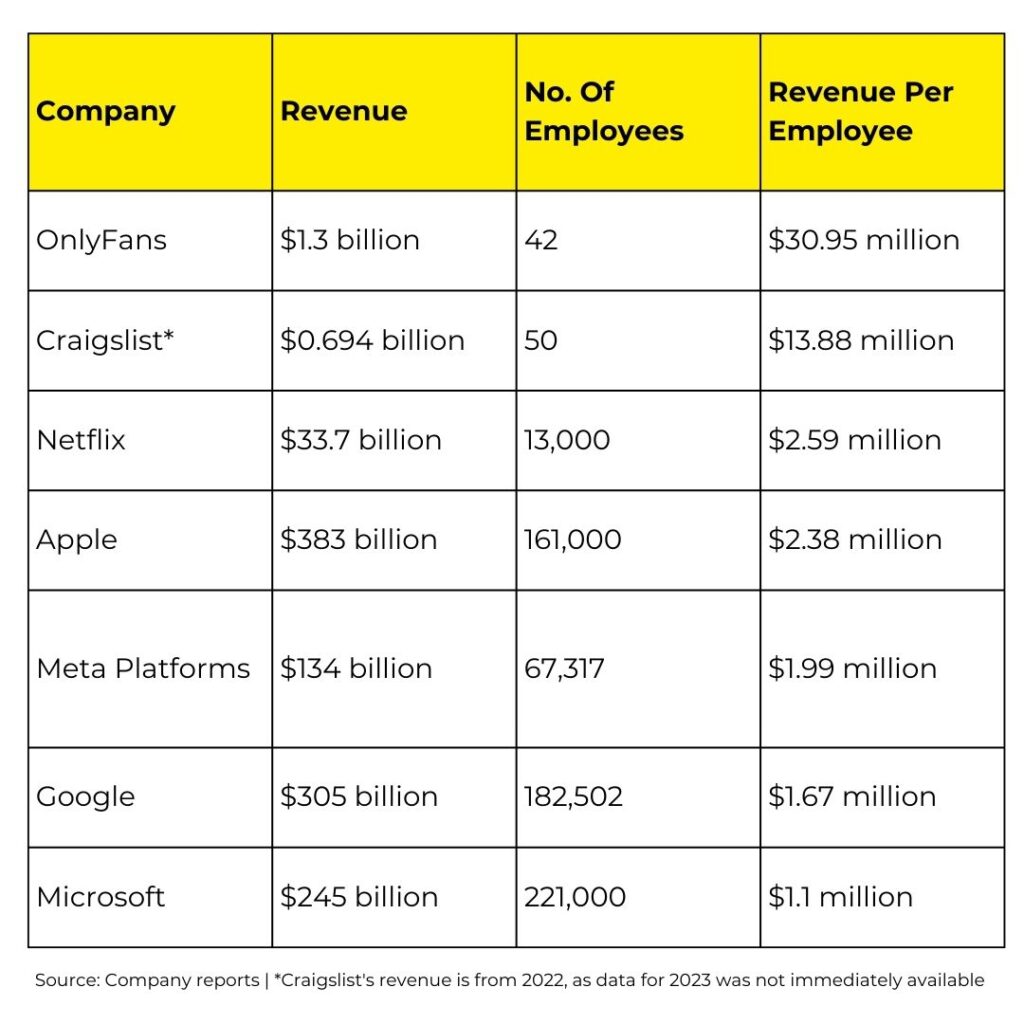- OnlyFans generates significantly higher revenue per employee compared to tech giants like Apple, Google, and Microsoft, with each of its 42 employees contributing nearly $31 million annually, a figure 28 times higher than Microsoft’s.
- The platform’s lean, decentralized model leverages 2.1 million independent creators to drive revenue, allowing OnlyFans to maintain a small workforce while profiting from the creator economy’s scalability and personalized content.
- This trend highlights a shift towards digital-first business models that emphasize gig work and flexible structures, signaling a potential future where smaller, leaner companies relying on freelancers outperform traditional corporate giants in profitability.
In the world of big tech, it’s no secret that companies like Apple, Google, and Microsoft dominate the revenue charts.
However, when it comes to revenue per employee, there’s an unexpected leader that’s beating the industry titans: OnlyFans.
With only 42 employees, the content-sharing platform is bringing in an astonishing $1.3 billion annually — meaning each employee represents nearly $31 million in revenue. That’s 28 times more than what employees at Microsoft, for example, contribute.
 But it’s not just revenue-per-employee that puts OnlyFans in the spotlight.
But it’s not just revenue-per-employee that puts OnlyFans in the spotlight.
According to a recent report, OnlyFans now tops the chart as the most lucrative side hustle in the United States, surpassing giants like Uber and DoorDash. The platform’s meteoric rise isn’t just benefiting creators — its business model has redefined what a financially successful company can look like.
So, what does this say about the future of work, and how does OnlyFans’ small team outperform tech giants with hundreds of thousands of employees?
Here’s a deep dive into the factors behind this massive revenue-per-employee gap and what it reveals about the future of digital-first business models.
The Shift to Lean, High-Profit Models
The major difference between OnlyFans and companies like Apple or Google is the nature of their business models.
OnlyFans runs on a lean operation, with much of the heavy lifting done by its creators — 2.1 million of them — who are not technically employees but contributors.
This decentralized workforce means that OnlyFans can focus on platform maintenance, payment processing, and content moderation, while its creators drive traffic, engagement, and revenue.
In contrast, tech giants like Apple and Microsoft operate complex ecosystems with massive internal teams handling product development, sales, customer support, and more.
Despite their enormous revenues, this workforce dilutes the per-employee revenue metric.
The Power of Creator Economies
OnlyFans taps directly into the growing creator economy, which thrives on personalized, user-generated content.
Creators, largely independent freelancers, generate the platform’s revenue by selling subscriptions and pay-per-view content directly to their fans. This gig economy model allows for more scalability without significant overhead — something traditional tech companies struggle with as they scale up.
Individual employees at OnlyFans each oversee a vast network of creators, and the platform takes a 20% commission on all transactions, according to the company’s own published Terms of Use.
With its user base of 190 million active users, the result is massive profitability with minimal staffing.
Are Big Tech Companies Bloated?
The startling difference in revenue-per-employee highlights a potential inefficiency in the traditional tech giants’ organizational structures.
With huge research and development, operational and marketing teams, these companies focus on building expansive ecosystems and product portfolios. While this makes them industry leaders in terms of overall revenue, it also underscores a fundamental difference in how modern companies like OnlyFans are able to operate more efficiently.
What This Means for the Future of Work
OnlyFans exemplifies a trend toward leaner, digital-first operations that rely heavily on freelancers and independent contributors rather than salaried employees.
As more companies explore platform-based business models, we may see a shift toward similar structures in other industries — especially as the demand for flexibility and autonomy grows within the workforce.
Tech companies could look to platforms like OnlyFans for inspiration on how to run more profitable, scalable businesses with smaller internal teams, relying instead on an ecosystem of contributors.
This may not only lead to higher profitability but also a new balance in work structures, where traditional employment could become less common, and gig or freelance work more mainstream.
In the end, while companies like Apple, Microsoft, and Google dominate in terms of overall market size, OnlyFans represents a new frontier — one where streamlined teams, digital ecosystems, and the creator economy could very well set the stage for the future of work.
The question is: will tech giants adapt, or will platforms like OnlyFans continue to redefine what a successful company looks like?
Subscribe to our Future of Work Newsletter to keep up with this story and to receive more like this.


 Dr. Gleb Tsipursky – The Office Whisperer
Dr. Gleb Tsipursky – The Office Whisperer Nirit Cohen – WorkFutures
Nirit Cohen – WorkFutures Angela Howard – Culture Expert
Angela Howard – Culture Expert Drew Jones – Design & Innovation
Drew Jones – Design & Innovation Jonathan Price – CRE & Flex Expert
Jonathan Price – CRE & Flex Expert















